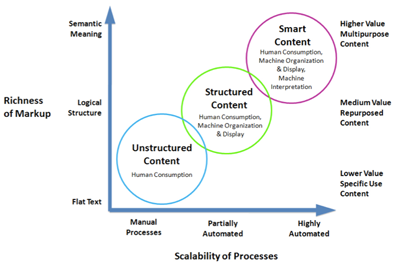The Metadata Object Description Schema (MODS) is an XML-based bibliographic description schema developed by the United States Library of Congress’ Network Development and Standards Office. MODS was designed as a compromise between the complexity of the MARC format used by libraries and the extreme simplicity of Dublin Core metadata.
Category: Content management & strategy (Page 98 of 483)
This category includes editorial and news blog posts related to content management and content strategy. For older, long form reports, papers, and research on these topics see our Resources page.
Content management is a broad topic that refers to the management of unstructured or semi-structured content as a standalone system or a component of another system. Varieties of content management systems (CMS) include: web content management (WCM), enterprise content management (ECM), component content management (CCM), and digital asset management (DAM) systems. Content management systems are also now widely marketed as Digital Experience Management (DEM or DXM, DXP), and Customer Experience Management (CEM or CXM) systems or platforms, and may include additional marketing technology functions.
Content strategy topics include information architecture, content and information models, content globalization, and localization.
For some historical perspective see:
https://gilbane.com/gilbane-report-vol-8-num-8-what-is-content-management/
Smart content is structured content that also includes the semantic meaning of the information. The semantics can be in a variety of forms such as RDFa attributes applied to structured elements, or even semantically names elements. However it is done, the meaning is available to both humans and computers to process.
See:
Global businesses recognize the need to address localization and translation in tandem with content creation and content management, but they are often stymied, even overwhelmed, by how to achieve this. Our research points to the emergence of what we define as the Global Content Value Chain, a strategy for meeting these challenges. Organizations embracing this strategy are leading the development of much-needed best practices.
See the free report (93 page PDF):
Multilingual Communications as a Business Imperative: Why Organizations Need to Optimize the Global Content Value Chain
by Leonor Ciarlone, Karl Kadie, & Mary Laplante, July, 2008
‘Document computing’ was a term used to cover a collection of technologies that emerged as computer, or electronic publishing became a growing industry late 1980s and early 1990s. The idea was to differentiate the creation, management and delivery of unstructured data from the traditional and still prevalent structured data orientation of computing applications. It was one of the keynote topics at the first Documation conference in 1994 . Also see the more current, largely overlapping ‘content technology’.
Also see:
Gilbane Report Vol 6, Num 1 — Document Computing – Is This Our Business?
Language afterthought syndrome refers to that pattern of treating language requirements as secondary considerations within content strategies and solutions. Global companes leak money and opportunity by failing to address language issues as integral to end-to-end solutions rather than ancillary post-processes. Examples abound. Source and translated content that should be reusable, but isn’t. Retrofitting content to meet regulatory requirments in different regions. Lost revenue because product and marketing content isn’t ready at launch time. Desktop publishing costs that are incurred soley due to reformatting in multiple languages. The list goes on and on.
See:
Insight from the Real World: Buying a WCM Solution for Multilingual Web Presence
“Content globalization” is the process of ensuring content is available in multiple languages. It is a subset of “internationalization” which also includes “localization” the process of ensuring the user interface and language use in a product is tailored to a local region.
Example case study:
Global Content Management: Hewlett-Packard Talks the Talk of Worldwide Business
In the early days of information technology (1950s – 1970s), computers were mostly mainframes and the information mostly structured data managed by information systems based on hierarchical and then relational databases.
With the emergence of descriptive markup languages such as SGML, XML, and JSON that add structure other forms of unstructured data or content such as text and streaming data, as well as NoSQL and graph database, linked data, and knowledge graph technologies, the distinction between structured and unstructured data or content is less relevant. Modern data lakes store structured, semi-structured, and unstructured data.
“Content technology” is a form of information technology that uses computing technology to create, retrieve, process, manage, store, share, and distribute unstructured data, such as narrative text and audio visual media, and typically incorporates or integrates with systems that manage structured data . The term emerged as early web content management systems proliferated, but includes any technology that processes some form of unstructured data, such as authoring, publishing, natural language processing, search and retrieval.


